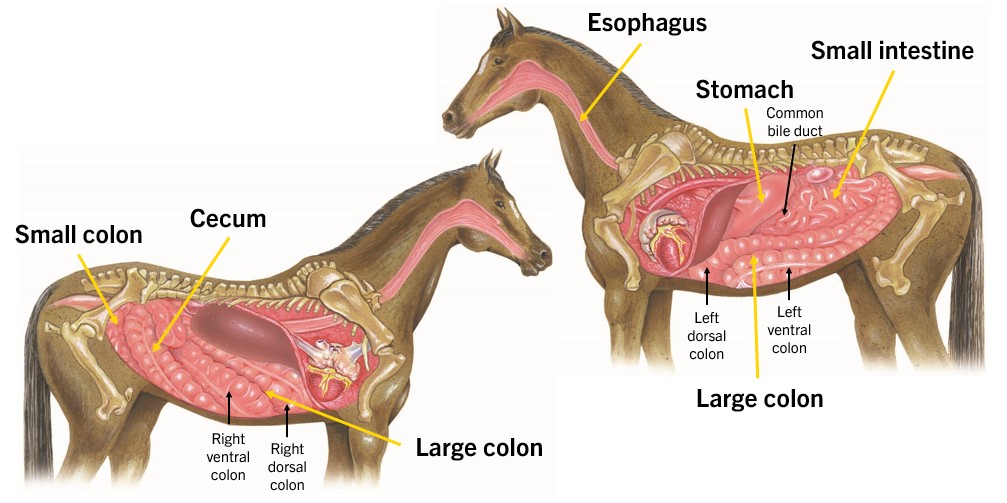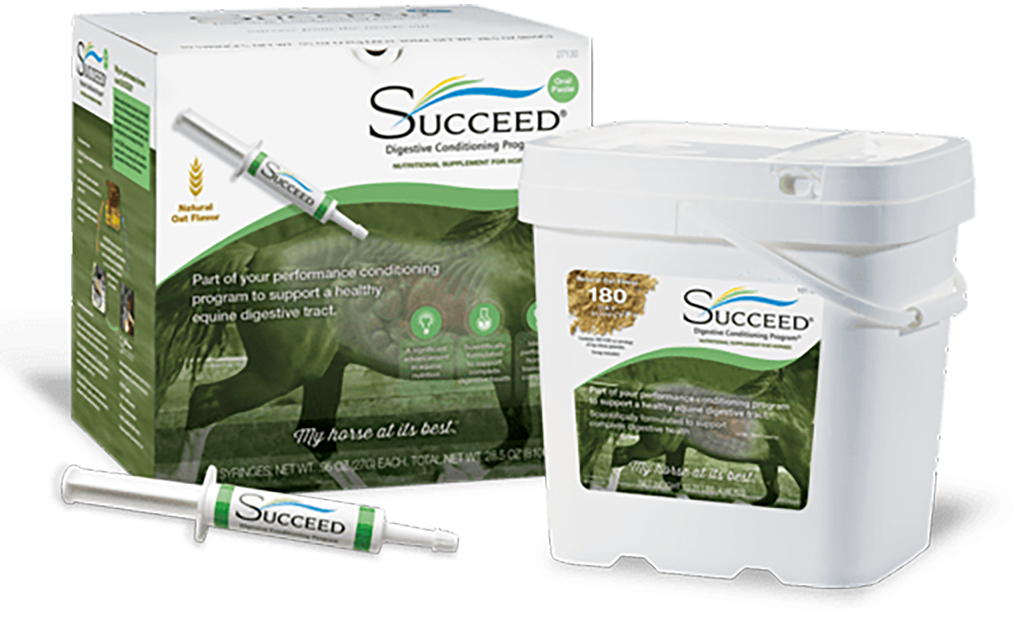
What the Digestive Process Looks Like in Horses
Breakdown Begins in the Stomach
- Digestion begins in the mouth, where horses ingest and chew feed before it moves down through the esophagus and into the stomach.
Chewing triggers the production of saliva, which is alkaline and acts as a buffer for stomach acid.
- The equine stomach produces acid continuously, whether the horse is eating or not, to break down feed for absorption.
The stomach is very small, roughly the size of a football, and feed only remains here for around 45 minutes. It has two regions: the lower glandular area and the upper squamous area. The glandular portion has a mucosal barrier that protects it from acid while the squamous region is unlined and unprotected. Acid is produced by proton pump cells, a “carpet” of cells found throughout the squamous region of the stomach.
A constant trickle of forage into the stomach creates a “mat” that absorbs acid, while saliva also buffers acidity, thereby protecting the sensitive squamous area. It’s important to maintain these natural protective mechanisms while also preventing acid production from becoming excessive and irritating the stomach lining.
Nutrient Absorption in the Small Intestine
- Feed then enters the small intestine which absorbs proteins, fats, and simple carbohydrates.
The small intestine is a 70-foot long tube that absorbs these nutrients out of feed. Feed moves through at a rate of about one foot per minute. So, in less than two hours, feed has already moved through the foregut and into the hindgut.
- The common bile duct secretes enzymes to further breakdown vitamins, minerals, and starches.
Horses have a common bile duct about 8-10 inches into the small intestine which further assists in the breakdown of simple carbohydrates. It is activated by a small amount of acid in the feed contents.
It’s critical for simple carbohydrates from grain to be fully digested here in the foregut. In nature horses eat very little of this, but our horses have higher energy requirements and thus may require higher-calorie feeds. Grains must be fed in small amounts, or moderated through digestive support, in order to be fully digested in the foregut.
Fermentation in the Hindgut
The bulk of digestion happens in the hindgut, which represents the majority of the horse’s digestive tract. Forage remains here for 2-3 days, where it is fermented by the microbiota and absorbed, providing most of a horse’s calories.
- Forage moves first into the cecum, a large, bacterial mixing vat that sits in the horse’s right flank.
Here, feed matter mixes with “beneficial” bacteria that digest fiber.
- Forage then moves into the large colon where it continues to ferment for several days.
Fiber-fermenting bacteria release volatile fatty acids (VFAs), the primary energy source for horses. VFAs and other byproducts of fermentation are then absorbed through the intestinal walls and into the bloodstream. Up to 70 percent of a horse’s energy, or calories, come from this process.
Note that when undigested starch reaches the hindgut, bacteria digest it and convert it into lactic acid instead of VFAs. Lactic acid kills off the beneficial bacteria and allows the proliferation of more beneficial bacteria, upsetting the healthy balance of the microbiota. This can lead to a cascade of issues in the GI tract and elsewhere throughout the body.
Feeding appropriately to support healthy hindgut fermentation, and supplementation to support a balanced digestive tract, are critical for today’s horse and it’s overall wellbeing.
- Finally, ingesta moves through the small colon, where water is absorbed from the remaining dry matter, creating fecal balls that exit through the rectum.
Digestive Challenges in Performance Horses
Disruptions at any stage of the digestive process can result in significant gastrointestinal problems. Therefore, supporting the entire digestive system when managing GI tract health is vital.
Equine Digestion and SUCCEED®

Is SUCCEED right for you?
Find out if your horse’s health and performance could benefit from added digestive support.
